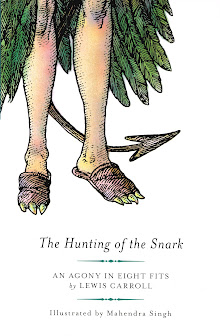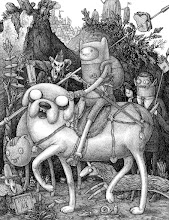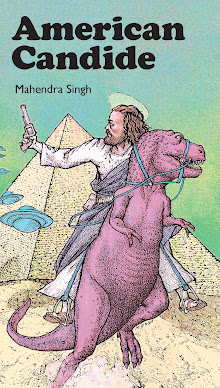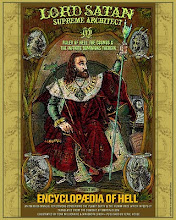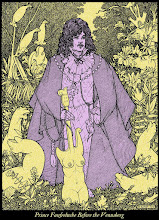We are not famed for the number of things we forget, we are infamous for remembering far too much useless Snark trivia. So, in lieu of introducing the penultimate crew member of the HMS Snark, we offer you instead these brain-droppings:
Snark Trivia: The Snark's last line was composed in the birthplace of P.G. Wodehouse and the final terrestrial abode of Ford Prefect — Guildford, Surrey!
Snark Trivia: A possible etymology for Snark is the German verb schnarren, to jar or buzz, itself cognate with the Low German snarren, to snarl. A friend of Lewis Carroll's, Beatrice Hatch, wrote in 1898 that the author had told her that Snark was a portmanteau of snail and shark. Pshaw! The Great One never made things that easy.
Snark Trivia: Dante Gabriel Rossetti was convinced in his later, even less rational years, that Carroll intended the Snark to symbolize himself. Rossetti also identified himself with wombats to an unhealthy degree and eventually disinterred his wife to retrieve some poems which he had entrusted to her coffin, which is far more devious than the usual authorial tactic of shoving a manuscript into a drawer and hoping it reads better a year later.
Totally Unrelated to Anything Snark Which Makes It Perfectly Snark: Marie Osmond's letter-perfect phonetic performance of Hugo Ball's Karawane is American pop culture's greatest Snark moment ever. Today, we live in an age of pop culture pygmies, thank god.
Monday, April 24, 2017
Monday, April 17, 2017
The Snark From Another Planet
All aboard! At one and the same time, the Bellman delivers himself from an impending watery grave, snatches a coveted berth aboard the H.M.S. Snark, tingles his bell to signal our departure and introduces the Beaver, who is busily engaged upon her salubrious lace-making.
I am aware that readers assume the Beaver to be a He. Carroll's text is ambiguous on the point, only using the masculine (possessive) pronoun in the plural to refer to the Beaver and another (usually the Butcher). In his Annotated Snark, Martin Gardner concurs on this important grammatical point, which is reinforced in my mind by its aesthetic rightness.
Inasmuch as the Snark is an imaginary animal and thus its clochetic pursuer triply so, and inasmuch as beavers are usually riparian, sedentary and unimaginably disinterested in travel and the needletrade, be it resolved:
No Bellman can step into the same river twice, for there is no Bellman, nor any river (or else he could step into it twice) and hence, all other passengers of any vessels upon these waters are also unreal, or at least up for some ontological gender-bending.
QED, the Beaver's a She and not a He and any arguments to the contrary are futile, for nothing will come of nothing. Speak again of this matter and I will invoke my Aristotelian rights: nature abhors a void, especially a kingly third portion (AKA the artists' Law of Thirds). Now stop learing at this nice drawing and get busy googling Heraclitus and Shakespeare, the bookends of occidental thinkery.
I am aware that readers assume the Beaver to be a He. Carroll's text is ambiguous on the point, only using the masculine (possessive) pronoun in the plural to refer to the Beaver and another (usually the Butcher). In his Annotated Snark, Martin Gardner concurs on this important grammatical point, which is reinforced in my mind by its aesthetic rightness.
Inasmuch as the Snark is an imaginary animal and thus its clochetic pursuer triply so, and inasmuch as beavers are usually riparian, sedentary and unimaginably disinterested in travel and the needletrade, be it resolved:
No Bellman can step into the same river twice, for there is no Bellman, nor any river (or else he could step into it twice) and hence, all other passengers of any vessels upon these waters are also unreal, or at least up for some ontological gender-bending.
QED, the Beaver's a She and not a He and any arguments to the contrary are futile, for nothing will come of nothing. Speak again of this matter and I will invoke my Aristotelian rights: nature abhors a void, especially a kingly third portion (AKA the artists' Law of Thirds). Now stop learing at this nice drawing and get busy googling Heraclitus and Shakespeare, the bookends of occidental thinkery.
Monday, April 3, 2017
Wag the Snark
The Dramatis Personae of this Snark GN continues … immediately to the right of the Bellman is the Broker, AKA Karl Marx. To the latter's right is the Billiard-Marker, AKA Raymond Roussel. If — and the thing is wildly possible — the charge of drawing nonsense were ever brought against the illustrator of this brief but instructive poem, it would be based, I feel convinced, on this panel. Messers Marx and Roussel were both notable figments of each other's imagination, each believing the other an opiate of the masses or a mass of opiates.
The treason of reality, so scandalous, so flattering! Or even better, to paraphrase Magritte (who knew a thing or two about snark hunting), CECI — IL N'EST PAS UN ARTIST.
The treason of reality, so scandalous, so flattering! Or even better, to paraphrase Magritte (who knew a thing or two about snark hunting), CECI — IL N'EST PAS UN ARTIST.
Subscribe to:
Posts (Atom)




